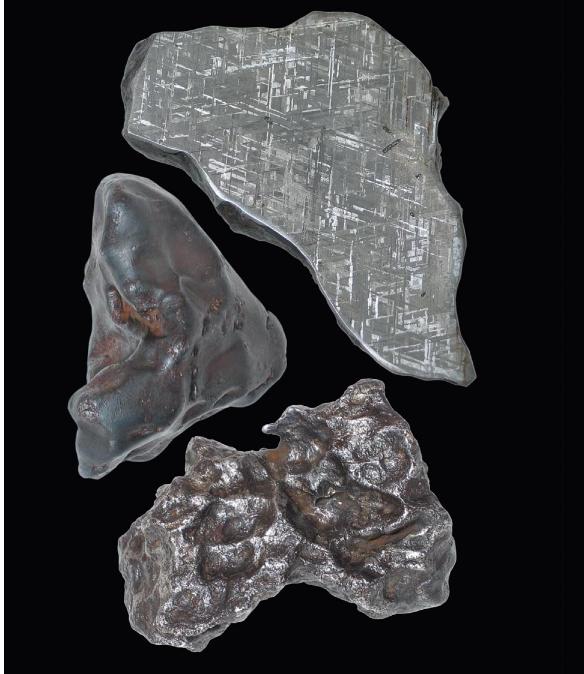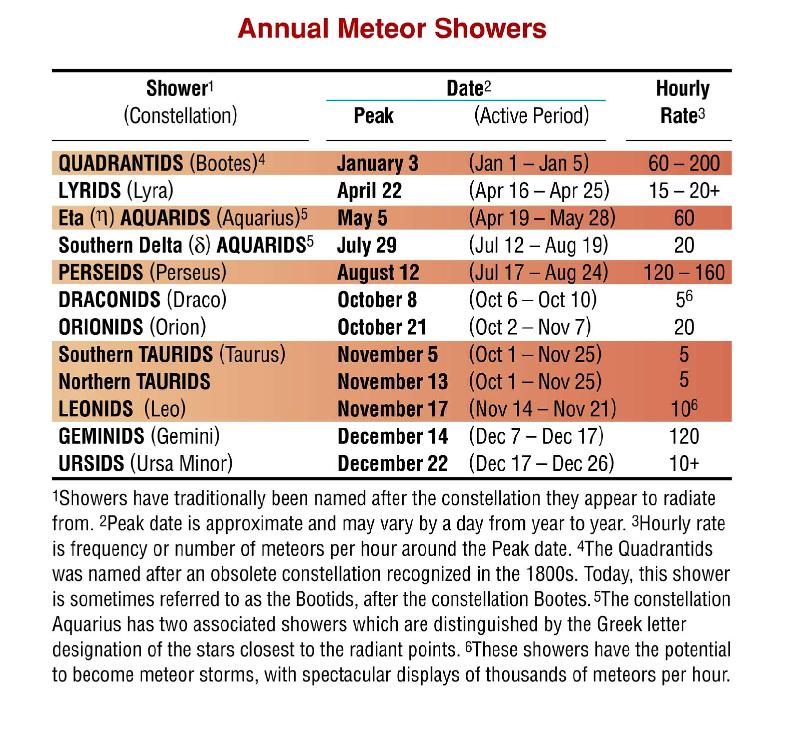 |
|
|
|
||
 |
||
Facts about Meteor Showers There are 12 “major” annual meteor showers that occur 8 months out of the year. Some are better than others but all are the result of depris left over from comets that have come close to Earth. The average size of the “stone” that burns up in our atmosphere to create the meteor streak is the size of a grain of sand! On average, about 7 meteors per hour can be seen with the eyes on any given night but the showers increase this number by 10 to 100 or more and sometimes, the showers produce longer and brighter meteors. How to observe: The very best time to observe meteor showers is in the early morning because the “forward” side of Earth is rushing into them, but anytime is fine. Sit comfortably in a chair or, better yet, lay back in a lounger so that you can see more of the sky. You DO NOT have to face any particular direction because meteors will appear to come from all parts of the sky.
Right. Three iron meteorites whose composition is mostly iron and nickel. At the top is a slice that has been polished and etched with nitric acid to bring out the crisscrossing Widmanstatten pattern, a pattern unique to metal rocks that formed in space. The cone-shaped meteorite in the middle was so shaped by air during its steady passage through the atmosphere. The bottom meteorite is covered with dimples that are informally called thumbprints, formed by tumbling through the atmosphere with the passing air blowing “bowls” into the molten surface. These meteorites originated from the asteroid belt and would have been seen as fireballs in the sky. |
 |
|||
 |
||
METEOR SHOWERS On a typical clear night, while looking at the sky, you stand a good change of seeing a meteor, commonly called a shooting or falling star. In fact, normally, about seven meteors per hour can be seen. But at specific times of the year, there are meteor showers which may allow you to see 15 to 100 meteors per hour. On very rare occasions, and if you are very fortunate, you may witness a storm with thousands of meteors falling per hour. Meteoroid, Meteor and Meteorite Meteoroid “Small rock in space (or grain of sand) Size, Speed & Height The Bright Ones Meteor Showers Meteors associated with showers radiate from a spot in the sky, so showers are named after the constellation from which the meteors appear to originate. The constellation Aquarius has two associated showers which are distinguished by the Greek letter designation of the star closest to the point of origination. New showers will be established when future cometary debris crosses Earth’s orbit. Existing showers will eventually fade away as debris dissipates. The Perseids have been around for a thousand years, while there is no indication of the Quadrantids further back than 200 years. |
Meteor Storms The Draconids and Leonids are currently the only known showers capable of storms. Storms result when the Earth hits pockets of concentrated silicate particles. At this time, scientists cannot accurately predict the occurance of storms. Debris from new comets in the future may also produce such displays. Observing Meteors & Showers The first time you see a meteor, you will probably say, “What was that?” And, unless you are looking in the direction of the meteor, you will only catch it out of the corner of your eye, but it will be exciting even then! Meteors not associated with showers are called sporadic meteors. Both sporadic meteors and shower meteors can appear anywhere in the sky. Although the meteors from showers originate from a small spot in the sky, this will not be immediately apparent when you watch showers. So, it is not necessary to face the constellation associated with the shower. I have found that lying on a lawn chair and looking up is not only comfortable, it also allows you to see the most sky possible. Although the most favorable time to observe meteors or showers is from around midnight to early morning when the night side of the Earth is moving toward the meteoroids, don’t let this dissuade you from watch during the more convenient early evening. And, the viewing is best when the Moon is not out. |
|||
What’s Out Tonight? is sponsored by Ken Press, publisher of astronomy books and charts. |
||